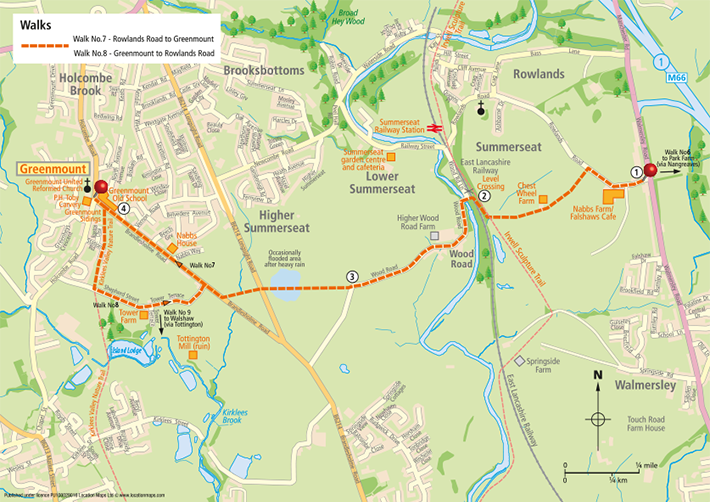|
|||||||||||||||||||||||||||||||||||
|
|||||||||||||||||||||||||||||||||||
|

| Click to download walk | |
| Greenmount Village owes its existence to the building of a Sunday school in 1848 in what was then the outskirts of the village of Tottington. The founders named it Green Mount Independent Sunday School. People living nearby included Green Mount in their postal address and this gradually extended to the surrounding area and soon it became a village. The original Sunday school is now the community centre owned by the church and now called Greenmount Old School. | |
| The stone wall of its car park is the only remaining evidence that you are standing on a bridge. The Bury to Holcombe Brook electric railway line went under the bridge. During the 1960s the deep cutting was filled in before the houses could be built. | |
Cross the road to enter the Kirklees Valley Nature Reserve, down the slope through what was Greenmount Station and goods yard. Continue following the main track until a lane (Shepherd St) crosses the track. |
|
| It’s believed that Ralph Rooney, a much loved character and famed long distance walker, was born in Shepherd Cottages (since demolished) in 1862. | |
| Turn left down the lane passing Tower Court, previously a farm and stable block. | |
| Joshua Knowles built Tower Farm in 1840, with a wonderful, fifty square-foot crenellated water tower with a row of small corbelled arches around the top to replicate the projecting gallery at the top of medieval castle walls years ago with openings in the floor through which stones and boiling liquids could be dropped on attackers. Immediately above the imposing archway entrance to the courtyard is the inscription J.K.1840. The construction is modelled on Nuttall Hall Farm, Ramsbottom an earlier building with 14th century origins, now demolished. Tower Farm was built to stable the many heavy horses required to bring coal from Mountain Mine in Affetside and transport raw goods to, and finished goods from Tottington Mill to Bury and elsewhere. Twelve years later both Knowles and one of the Grants were on the committee of four who raised the funds and organised the building of Peel Tower on Holcombe Hill using exactly the same architectural style. | |
| Continue down the track, past the cottages to the junction with Brandlesholme Road (built in the early 1800s as a toll road). Cross over, looking out to the right for the footpath sign by the hedge. Take the path across the field and footbridge on to Longsight Road, also an early 1800s toll road. (Note. The kissing gate at the end of the bridge is rather a tight fit for the ‘fuller’ figure) Cross over Longsight Road, go through the 5 barred gate opposite, take the path by the hedge on the left. Fifty metres along the path go left over the stile. Looking ahead at the hills in the distance above Walmersley, you will note a distinct notch or vee which is a classic example of a glacial overflow channel formed during the last ice age. Carry straight on passing by the pylon on the left to join Wood Road. |
|
| Please note after heavy rain this first section of the path, just after the stile may be flooded. The alternative is to return to the main road, turn left and stay on the footpath, take next left onto Wood Rd to re-join the route. | |
| Continue down Wood Road and through the hamlet at the bottom of the hill, also called ‘Wood Road.’ Shortly after leaving the hamlet the road crosses the River Irwell. Immediately before the bridge on the left there is a public footpath to Summerseat station and Garden Centre. |
|
| The East Lancashire Railway was opened in1846 to serve local mills, but closed to passenger traffic in 1972 and then commercial traffic in 1980. A spirited campaign restored the Bury to Ramsbottom line and it reopened in 1987. Since then this heritage line, now carrying 120,000 passengers a year, has been extended twice to run between Heywood and Rawtenstall. It is run by volunteer members of the East Lancashire Railway Preservation Society every weekend and bank holiday throughout the year (and mid-week in summer). They arrange all sorts of events from a Real Ale Trail to Steam Experience Days, War Weekends and Santa Specials at Christmas. It is also an excellent spot to capture pictures of steam engines (including the Flying Scotsman) working hard as they round the bend coming up from Bury and difficult to imagine years ago every morning around 8.15 the London train, biggest and heaviest of the day, made the ground tremble, roaring south over this very spot. |
|
| The Irwell Sculpture Trail is the largest public art scheme in England, commissioning regional, national and international artists. The trail includes 28 art pieces and follows a well established 30-mile (48 km) footpath stretching from Salford Quays through Bury into Rossendale and up to the Pennines above Bacup Just south of here is Burrs Country Park and Castlesteads, the site of a ‘Promontory Fort’ overlooking the Irwell. Archaeological excavation of the site in 1992 revealed that it dates back to the late Iron-Age, having been occupied between 200BC and AD250. This means that the settlement site continued in use long after the Romans had arrived in Britain. The site is now a ‘Scheduled Ancient Monument’ in recognition of its national importance. | |
| Turn left at the end of the wooden broad walk and go through the next gate and follow the path up the field by the hedge on the left. At the top of the field go through the gate to the right of the Chest Wheel Farmhouse and a further two more around the front of the house. Join the track between the farm and Rowlands Road, Turn right onto Rowlands Road. |
|
| BACK TO TOP | |
